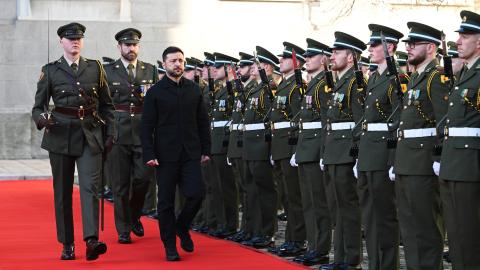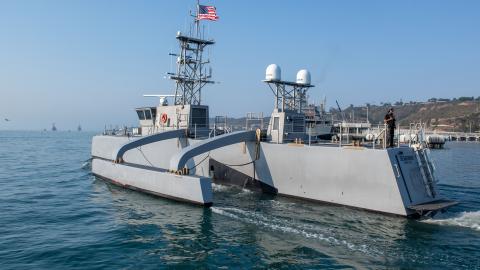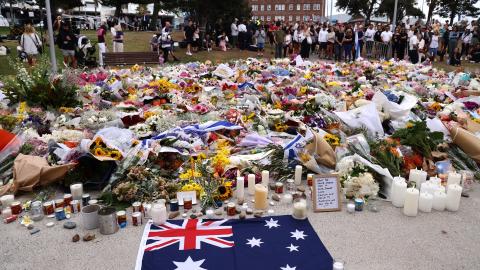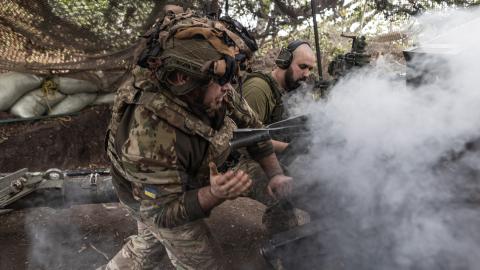Executive Summary
- Russia closes in on Kupiansk: Ukrainian authorities have begun to evacuate the embattled city amid intense combat operations in the region.
- Ukraine’s long-range strikes strangle Russia’s energy industry: The Kremlin announced a ban on the export of gasoline for the remainder of 2025.
- Enhancing Ukraine’s fighter fleet: While Stockholm and Kyiv have yet to reach a definite agreement, Ukraine’s first deputy defense minister announced that the Ukrainian Air Force is expecting to receive Swedish Gripen combat aircraft.
- Ukraine-NATO defense ties: The Ukrainian Navy took part in a North Atlantic Treaty Organization naval exercise centered on robotic maritime systems.
1. Battlefield Assessment
Fighting continued at a high operational tempo last week, with 120 to 140 tactical clashes each day. According to data circulated by the Ukrainian General Staff, 30 percent of these occurred around the long-embattled Pokrovsk sector, where Russian forces made advances. The area around Toretsk and the Lymansk sector each hosted roughly 10 percent of last week’s tactical engagements.
Russian forces continued to make incremental gains along the axis from Kharkiv to Kupiansk, prompting Ukraine to begin evacuating the latter city. Ukrainian press sources reported that covert Russian sabotage units have penetrated the area disguised as Ukrainian servicemen.
Heavy drone activity also continued throughout the battlespace. The area around Kharkivfaced intense Russian drone attacks. Dnipro bore the brunt of the salvo, which deliberately targeted the civilian population. Meanwhile, Ukrainian drones targeted 170mm Koksan self-propelled artillery pieces, which Russia received from North Korea.
Notably, signs emerged that Ukraine’s attacks on Russian oil infrastructure have made a significant impact. Open-source visual evidence indicates that Russia has been placing protective metal structures over its energy facilities to protect them from long-range Ukrainian drone strikes. The Kremlin also recently banned the export of gasoline until the end of 2025 in an effort to conserve its resources for domestic use.
2. Swedish Gripens Could Soon Join Ukraine’s Air Force
Ukrainian First Deputy Defense Minister Ivan Havrylyuk announced that Ukraine plansto acquire Gripen combat aircraft from Sweden, though Sweden and Ukraine have not reached a final agreement on the procurement of the fighters.
The transfer of these advanced fighters has long been in the offing. As early as 2023, Swedish Defense Minister Pål Jonsson offered to familiarize Ukrainian pilots with the Gripen platform. As their need for a more advanced air deterrent has grown, Ukrainian officials have become less reluctant to operate a European fighter aircraft alongside American-supplied F-16s.
Along with the Eurofighter Typhoon and the French Dassault Rafale, the Saab Gripen baseline is one of three principal European platforms operated by NATO member states. The Gripen family’s latest variant, the Gripen-E, was initially developed to replace older Gripen-C/D models. But the worsening threat landscape across Europe prompted Swedish military planners to equip some C/D platforms with modifications that extended their lifespan.
Thus far, the Swedish platform has not matched its competitors’ popularity in the international weapons market, nor have the world’s top militaries adopted the airframe. Still, Thai forces successfully used Gripens to target Cambodian artillery in the nations’ summer 2025 border dispute.
At the outset of Russia’s full-scale invasion of Ukraine, many Western analysts considered the Gripen the best option for Ukraine’s nascent advanced air deterrent. The Swedish Air Force has long centered its doctrinal approach on low-level air superiority concepts of operations that can succeed under severe pressure and from dispersed bases. Moreover, the Gripen requires a relatively modest crew. Operating the craft requires just two ground vehicles, six ground personnel, and one aviation maintenance professional. The Gripen can take off and land from highways, and it is designed to fly in temperatures as low as negative 78 degrees Fahrenheit. Finally, the aircraft’s electronic warfare suite has reportedly been optimized to counter Russian combat aircraft and air defense systems.
So while other fighters may have captured larger shares of the international weapons market and logged superior combat records, the Swedish Gripen could be the perfect European addition to Ukraine’s growing contingent of advanced aircraft.
3. Ukraine Joins NATO Naval Exercises
The Ukrainian Navy’s success in the Black Sea helped Kyiv secure a prominent place in the high-tech maritime exercises NATO put on last week.
This year’s exercises, in Portugal, focused on integrating unmanned systems into a connected operational environment. The drills combined two NATO initiatives: Robotic Experimentation and Prototyping with Maritime Unmanned Systems (REPMUS), a global showcase for military-grade maritime robotics; and Dynamic Messenger (DYMS), a part of NATO’s operational experimentation series. The exercise sought to assess new maritime capabilities including organic intelligence, surveillance, reconnaissance (ISR) measures, underwater infrastructure defense, and tactics to counter multi-domain unmanned vessels.
Co-organized by NATO’s Allied Command Transformation (ACT) and Allied Maritime Command (MARCOM) and hosted by the Portuguese Navy, the exercise deployed elements of Standing NATO Mine Countermeasures Group 2 and Standing NATO Maritime Group 1. The Ukrainian Navy played the enemy force, or the so-called red team. In the exercise, the red team had a force of one unmanned ground vehicle, 57 unmanned surface vehicles (USVs), and 61 aerial drones of varying designs. According to press sources, Ukraine’s hypothetical robotic flotilla also included the Magura V7 USV, which the real Ukrainian Navy reportedly used to shoot down two Russian Su-30SM combat aircraft earlier this year.
As its participation in these exercises demonstrates, Ukraine’s success against the Russian Navy in the Black Sea offers invaluable lessons for NATO. At present, the Ukrainian military boasts more experience with robotic naval combat operations than any other military in Europe. Ukraine’s success could significantly influence NATO’s future naval strategies and help foster continued maritime cooperation between the alliance and Kyiv.


















